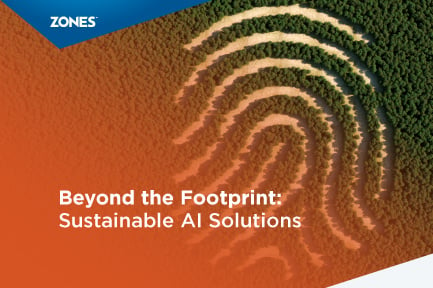2 min read
Dell Technologies Helps You Reach Net-Zero Emissions
Greenhouse gas emissions have a significant and potentially catastrophic impact on the climate. These emissions contribute to global warming and...
2 min read
![]() Zones
:
Jun 25, 2024 9:09:48 AM
Zones
:
Jun 25, 2024 9:09:48 AM

Innovations like artificial intelligence (AI) hold the promise of transforming industries and driving global economic growth. However, the significant energy and resources required to train and run AI models present a growing environmental challenge. Balancing the advancement of AI technology with sustainability commitments is critical. This blog explores how businesses can navigate this dual commitment—leveraging AI's potential while adopting practices to minimize its environmental impact. By investing in sustainable AI infrastructure and practices, organizations can achieve technological progress and environmental responsibility.
Artificial Intelligence and generative AI (GenAI) are revolutionizing industries and driving economic growth, but they come with significant environmental challenges. Training and operating large AI models requires immense computational power, consuming substantial energy and resources. This poses a dilemma for businesses striving to leverage AI while adhering to their sustainability commitments.
Despite these challenges, investment in both AI and sustainability is increasing. Gartner's 2023 CEO Survey reports that 94% of CEOs plan to maintain or increase their sustainability investments, while Dell Technologies’ research shows 76% of IT decision-makers are boosting their budgets for GenAI use cases. These trends highlight that advancing AI and achieving sustainability goals can coexist. By adopting energy-efficient practices and sustainable technologies, businesses can harness AI's potential while supporting a greener future.
The growing investment in AI and sustainability highlights an important dual commitment. While AI's potential to drive efficiency and productivity is immense, its energy demands cannot be ignored. Technological progress and environmental responsibility are not mutually exclusive goals; instead, they must be pursued in tandem to meet ambitious climate objectives.
Organizations are finding that sustainability and AI investments can complement each other. Smart technology investments, such as energy-efficient servers, environmentally responsible cooling methods, and renewable energy sources for data centers, can significantly reduce AI's carbon footprint. By prioritizing both innovation and sustainability, businesses can achieve technological advancement without compromising their environmental commitments.
To balance the environmental impact of AI, businesses must make smart and sustainable technology investments. This includes adopting modern, energy-efficient servers and storage devices, utilizing environmentally responsible cooling methods, and powering data centers with renewable energy. These steps can significantly minimize AI's carbon footprint.
Additionally, right-sizing AI workloads and infrastructure can enhance data center efficiency. While some organizations may benefit from large, general-purpose models, many only require domain-specific implementations. Flexible "pay as you go" models can help organizations save on data center costs while supporting sustainable IT infrastructure. These strategies ensure that AI advancements align with sustainability goals.
Building a sustainable AI infrastructure involves adopting best practices and innovative solutions that reduce energy consumption and environmental impact. One effective approach is to leverage local computing for prototyping, developing, and fine-tuning AI models. Running complex AI workloads on AI-enabled PCs locally can be more sustainable, cost-effective, and secure, reducing latency and energy use.
Another key practice is responsibly retiring inefficient hardware. By returning or recycling outdated technology, businesses can optimize data center performance and reduce e-waste. Programs that harvest components for reuse, refurbishment, and recycling extend the lifecycle of materials and support a circular economy, minimizing the need for new resources.
Addressing the environmental challenges of AI requires a proactive approach from the tech industry. Companies must lead by example, demonstrating that AI infrastructure development can align with climate goals. By modernizing technology and adopting sustainable practices, the industry can showcase the benefits of advancing AI while maintaining environmental responsibility.
Data center energy use, emissions, and e-waste are critical issues being tackled head-on. Using AI to optimize data center operations, track energy consumption, and improve workload placement can significantly enhance efficiency and reduce costs. Embracing these practices helps the industry harness AI's potential to support climate-related solutions, proving that technology and sustainability can go hand in hand.

2 min read
Greenhouse gas emissions have a significant and potentially catastrophic impact on the climate. These emissions contribute to global warming and...

Artificial Intelligence (AI) is a groundbreaking force in today's rapidly evolving technological landscape. From automating routine tasks to...

2 min read
The world is surging toward a climate catastrophe where global warming is expected to reach an irrecoverable state. In 2019, the world generated...